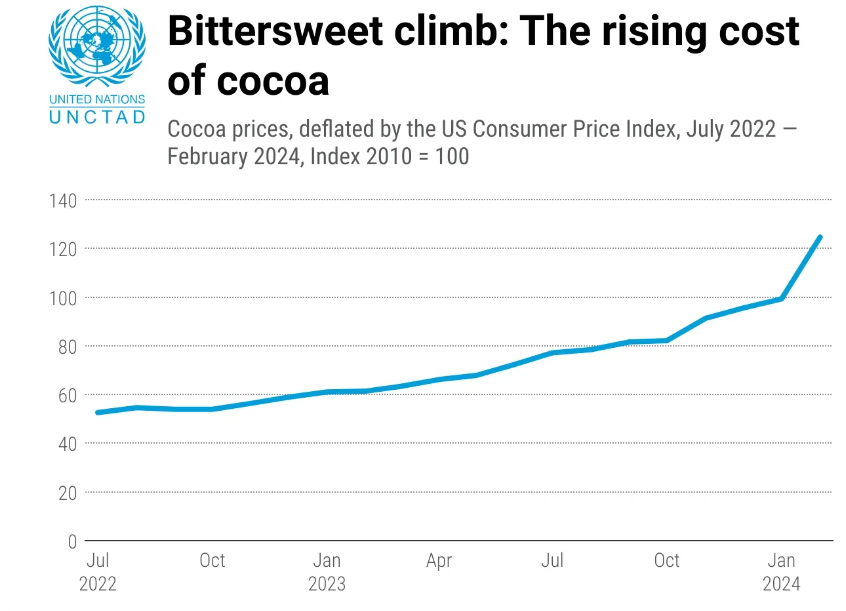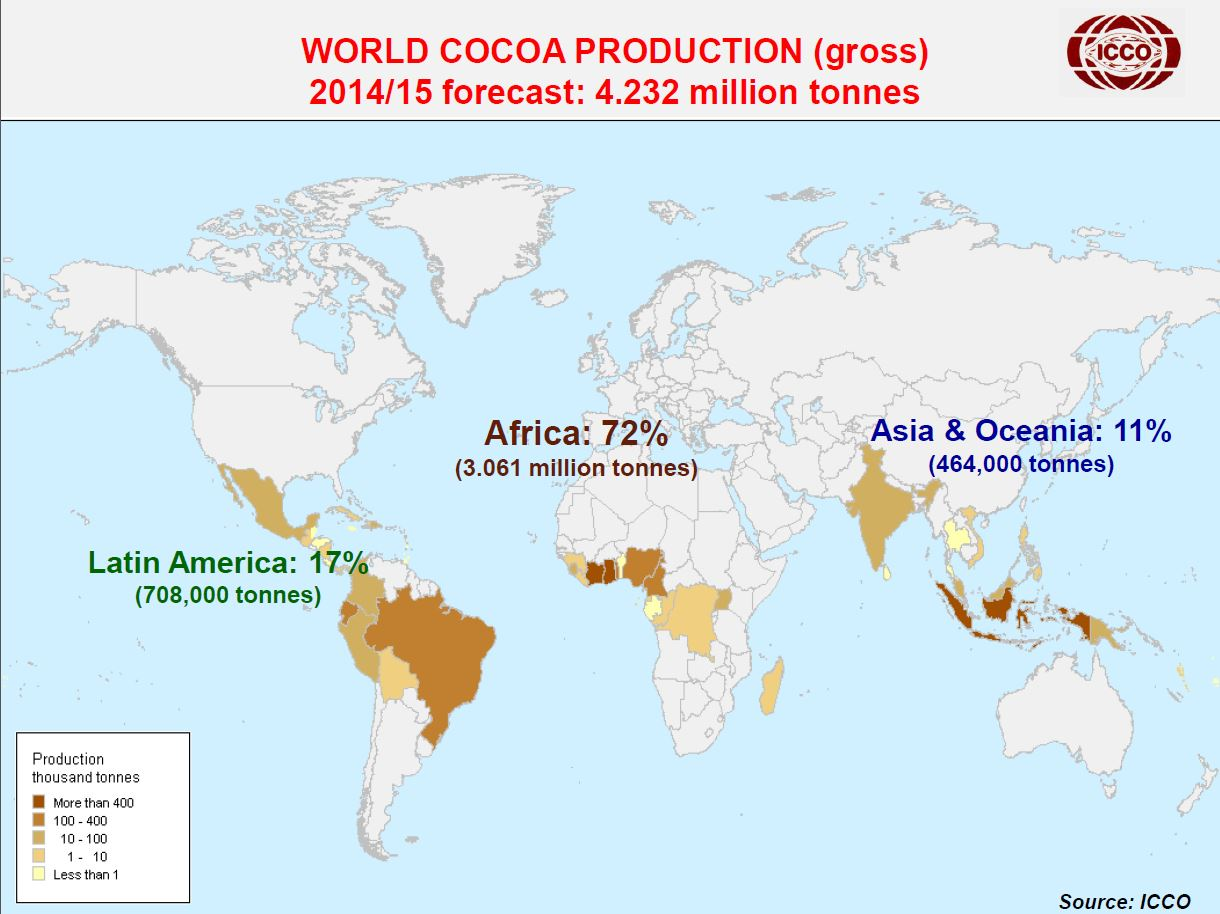Economy
Chocolate Industry Meltdown
- 10 May 2024
- 7 min read
For Prelims: El Niño, Heat waves, Climate change, Cocoa Cultivation , International Cocoa Organisation (ICCO)
For Mains: Impact of Climate change on Chocolate Industry, Significance of Policy Development for Cocoa Production in India
Why in News?
The chocolate industry is facing a crisis as the price of cocoa beans surges, reaching a record USD 12,000 per tonne in April 2024.
- This surge, nearly four times the price in 2023, has sparked concerns and drawn attention to the underlying causes behind the upheaval.
What are the Reasons Behind the Rising Prices of Cocoa?
- El Nino and Climate Change:
- The immediate reason for the ongoing crisis is the bad harvest season in West African countries Ghana and Ivory Coast, where 60% of the world's cocoa beans come from.
- The development of El Niño, a weather pattern that refers to an abnormal warming of surface waters in the equatorial Pacific Ocean, led to heavier-than-usual rainfalls in West Africa, creating an ideal ground for the spread of black pod disease, which causes cocoa pods to rot on the branches of cocoa trees.
- Climate change is also a driving factor, with Heat waves, droughts, and heavy rainfalls further threatening cocoa production, posing long-term challenges for farmers and chocolate manufacturers alike.
- Low Income for Cocoa Farmers:
- The underlying issue is that the big chocolate companies do not pay enough to the cocoa farmers in West Africa, who earn on average as little as less than USD 1.25 a day, which is well below the United Nations' absolute poverty line of USD 2.15 per day.
- Farmers are not able to invest in land to increase yield or build resilience against climate change due to the lack of funds, leading to the use of slave and child labour, and the selling off of land to illegal gold miners.
- As a result, the farmers continue to live in poverty, unable to invest in their land or adopt sustainable practices, leading to decline in production and price surge.
- Despite the huge profits made by the chocolate companies, they have not done much to help raise farmers' income, contributing to the long-term exploitation of farmers and potentially leading to higher chocolate prices for consumers in the long run.
- Potential Consequences of the Ongoing Crisis:
- The International Cocoa Organisation (ICCO) predicts a global shortfall of about 374,000 tonnes for the 2023-2024 season, exacerbating the scarcity of cocoa beans and driving up chocolate prices.
- ICCO is an intergovernmental organisation established in 1973 under the United Nations.
- Based in Abidjan, Ivory Coast, ICCO was created to implement the first International Cocoa Agreement negotiated in Geneva at a United Nations International Cocoa Conference.
- The scarcity of cocoa beans is likely to persist, leading to further exploitation of farmers and a rise in chocolate prices.
- Experts believe that the prominent chocolate companies have the room to redistribute wealth down the supply chain, but unless they do so, the situation is unlikely to improve.
- The International Cocoa Organisation (ICCO) predicts a global shortfall of about 374,000 tonnes for the 2023-2024 season, exacerbating the scarcity of cocoa beans and driving up chocolate prices.

Cocoa Cultivation Requirements
- Altitude and Rainfall: Cocoa can be grown up to 300 m above mean sea level. It requires a minimum of 90-100 mm rainfall per month with an annual rainfall of 1500-2000 mm.
- Temperature and Soil Conditions: Cocoa prefers warm and consistent temperatures, the temperature range of 15°- 39°C with an optimum of 25°C is considered ideal.
- Cocoa requires deep and well-drained soils. Poorly drained soil affects the growth of plants. The majority of the area under Cocoa cultivation is on clay loam and sandy loam soil. It grows well in the pH range of 6.5 to 7.0.
- Agroforestry: Cocoa trees thrive under shade and are often grown under the canopy of taller trees. This agroforestry practice not only helps in maintaining the required microclimate but also supports biodiversity.
- Cocoa Production in India:
- Cocoa is best cultivated in coconut and areca nut gardens in India, where 30-50% of sunlight can be intercepted by cocoa under the areca nut canopy.
- In India, it is mainly cultivated in Andhra Pradesh, Karnataka, Kerala and Tamil Nadu mainly as intercrop with Arecanut and Coconut.
- National Horticulture Mission provides a subsidy of Rs 20,000 per hectare to cocoa farmers in Andhra Pradesh for the first three years.
- Central Plantation Crops Research Institute Conducts systematic cocoa improvement programs with germplasm introductions.

|
Drishti Mains Question: How does climate change exacerbate challenges for cocoa farmers, and what are the implications on the chocolate industry? |
UPSC Civil Services Examination Previous Year Questions (PYQs)
Prelims:
Q. Aspartame is an artificial sweetener sold in the market. It consists of amino acids and provides calories like other amino acids. Yet, it is used as a low-calorie sweetening agent in food items. What is the basis of this use? (2011)
(a) Aspartame is as sweet as table sugar, but unlike table sugar, it is not readily oxidized in human body due to lack of requisite enzymes
(b) When aspartame is used in food processing, the sweet taste remains, but it becomes resistant to oxidation
(c) Aspartame is as sweet as sugar, but after ingestion into the body, it is converted into metabolites that yield no calories
(d) Aspartame is several times sweeter than table sugar, hence food items made with small quantities of aspartame yield fewer calories on oxidation
Ans: (d)




